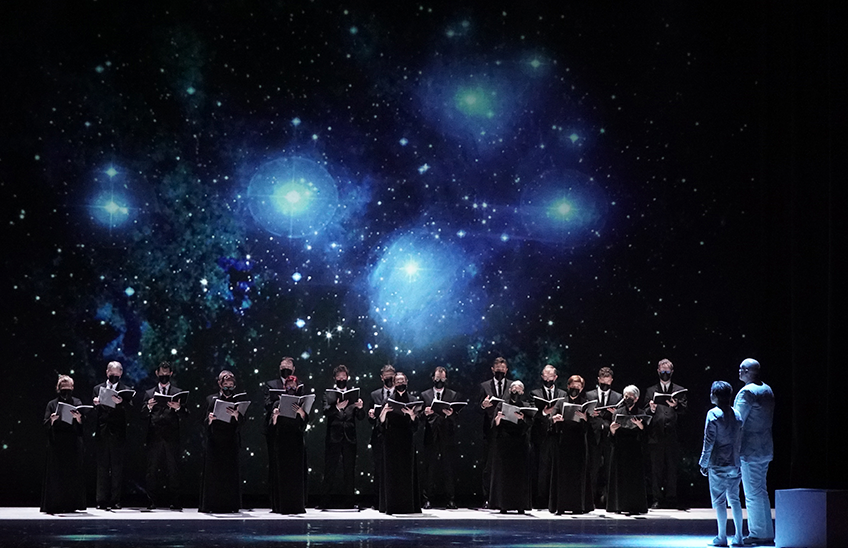The Museum hosts the world premiere of the chamber version of 'Atlàntida', by Manuel de Falla, a co-production with the Chamber Choir of Pamplona.
The piece, in which Ernesto Halffter also worked, will premiere on March 5, at 7:30 p.m., at the Theater of the Museum of the University of Navarra. Tickets are 18 and 20 euros

23 | 02 | 2022
Enigma, depth of meanings and Manuel de Falla 's singular look characterize Atlàntida, a colossal piece, called to be a masterpiece of the music of the 20th century and that the master left unfinished. After a meticulous work at musical, scenic and documentary level, the Teatro del Museo Universidad de Navarra welcomes its chamber version, next March 5, at 7:30 pm, in co-production with the Chamber Choir of Pamplona and with the necessary financial aid and partnership of the Foundation file Manuel de Falla. Tickets are 18 and 20 euros.
With musical direction by David Gálvez and stage direction by Tomás Muñoz, the project has been supported by INAEM, the Government of Navarra and the City Council of Pamplona. The piece, which opens the new edition of the cycle Cartografías de la Música, offers the public the scenic cantata in a chamber version, based on the so-called Lucerne version (1976) by Ernesto Halffter, but with parts added from Falla's original score, which give it a greater theatrical sense. For example, the death scene of the Pleiades is respected.
In his presentation, David Gálvez, director of the Pamplona Chamber Choir, explains that, until now, the work had been presented as "a choral symphonic work of great sonorous masses. But I always thought that it was an eminently chamber work in its elements, that if it was distilled correctly they would come to the surface and that it could work very well in a small format". In the meeting also participated Tomás Muñoz; Elena García de Paredes, General Manager of the Foundation file Manuel de Falla, and Teresa Lasheras, director of Performing Arts and Music of the Museum.
The musical director has also pointed out that "there were many elements in the original score that indicated that Falla advocated something smaller". Thus, in his proposal he proposes "not a reduction, but a faithful and rigorous translation of the existing materials for piano four hands and percussion". The choir will consist of 32 people. The intense work has allowed them "to bring to light many elements that, undoubtedly, are lost in the sonorous maelstrom of the choral symphonic work, although it has to remain there, of course", said Gálvez. "Our version streamlines the work, allows for a dynamic scene and is much simpler".
In this line, Muñoz has agreed to point out the "challenge major" that has meant to address this emblematic work, for which they have made a research to see the work from the viewpoint of Falla and "see where this Atlàntida could have gone unfinished". In this line, he has indicated the importance of taking into account the context. "It is a very difficult work to understand without understanding what Falla was like and his historical circumstances. We have tried to see it through his eyes, since he probably already dreamed it before composing it". Thus, he explained that, since he was a child, the composer was interested in the myth of Atlantis and the New World, with which he links it. The deep religiosity and morality of the maestro, together with the disenchantment caused in his life by the historical events that took place in Spain in the 30s, especially the Civil War, meant that, what at the beginning could have been conceived as a hymn to the Hispanidad, at the end of those 20 years in which he worked on it, ended up showing a vision staff and a certain vital discouragement.
As for the scenic proposal , Muñoz explains that he has worked to "strip away many of Halffter's additions, to also talk about his compositional difficulties" and also "see it as Falla saw it, with a series of transparencies, and it has been very important to start from the idea of the image, in this case projected, which has guided us".
For her part, Elena García de Paredes stressed that this chamber version makes "a great contribution to Atlàntida, one of Falla's most personal creations, and this is a very essential version". In this sense, he recalled that in this work the composer "wanted to put all his music, faith and creativity, of Falla as a child and as an adult. It is as if he opened a curtain, entered another dimension and wanted to collect it". He also values that this work has been a "real documentary adventure in manuscripts and letters, in which many things and points of inspiration can be found".
For the director of Performing Arts and Music of the MUN, "this musical and scenic work contributes to shed light on this capital work in the work of Manuel de Falla, as it was his most important work staff". He has also valued that it is "a current creation work that takes as its starting point a very important heritage element of Spanish music. And how to do it is one of the lines of research of the Museum". Finally, "it is very unusual to enjoy scenic cantatas, a hybrid format that also connects with the artistic lines of the MUN".
To learn more about this piece, on March 3, at 7 p.m., it will star in the session of the cycle How to do things with..., meeting open to the public with the participation of David Gálvez, Tomás Muñoz and Elena García de Paredes, and will be conducted by Nieves Acedo, director of Programs of the MUN. entrance free with prior withdrawal of invitation until fill in capacity.




